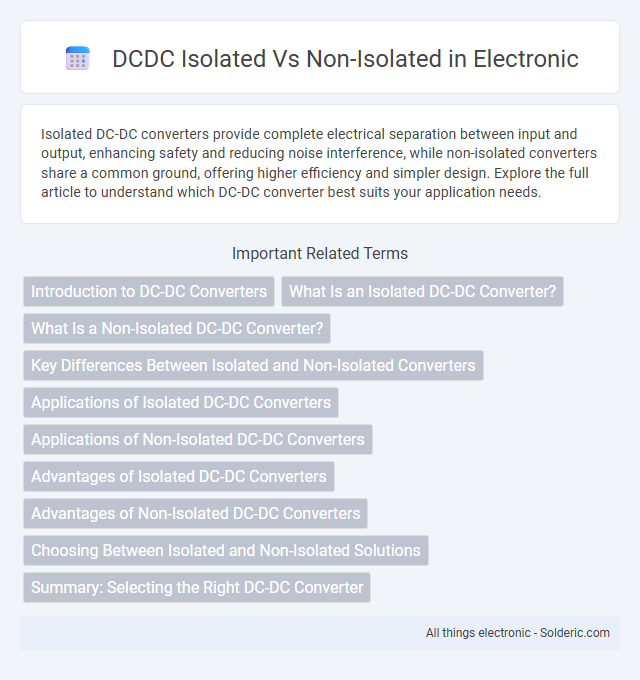Isolated DC-DC converters provide complete electrical separation between input and output, enhancing safety and reducing noise interference, while non-isolated converters share a common ground, offering higher efficiency and simpler design. Explore the full article to understand which DC-DC converter best suits your application needs.
Comparison Table
| Feature | Isolated DCDC Converter | Non-Isolated DCDC Converter |
|---|---|---|
| Electrical Isolation | Yes, provides galvanic isolation between input and output | No, input and output share a common ground |
| Safety | Enhanced safety, prevents ground loops and faults | Lower safety due to direct connection |
| Complexity | More complex design with transformers or optocouplers | Simpler design, fewer components |
| Cost | Higher due to additional components and isolation materials | Lower cost, minimal components |
| Efficiency | Typically lower due to isolation losses | Higher efficiency, direct energy transfer |
| Applications | Medical devices, industrial control, power system isolation | Battery-powered devices, simple power regulation |
| Size | Larger due to transformers and isolation barriers | Smaller and more compact |
Introduction to DC-DC Converters
DC-DC converters are power electronic devices designed to convert one DC voltage level to another, optimizing power efficiency in electronics and industrial applications. Isolated DC-DC converters include galvanic separation through transformers, ensuring safety and noise reduction in sensitive circuits, while non-isolated converters directly transfer energy using inductors or capacitors without physical isolation. The choice between isolated and non-isolated topologies depends on application requirements such as voltage levels, isolation needs, efficiency targets, and electromagnetic compatibility.
What Is an Isolated DC-DC Converter?
An isolated DC-DC converter features galvanic isolation between its input and output, typically achieved using a transformer, which enhances safety and noise immunity in sensitive applications. This isolation prevents direct electrical connection, reducing the risk of ground loops and enabling different voltage domains to coexist without interference. Isolated converters are essential in medical, industrial, and communication systems where protecting circuits and users from high voltages is critical.
What Is a Non-Isolated DC-DC Converter?
A non-isolated DC-DC converter transfers energy directly between input and output without electrical isolation, typically using a transformerless design like buck, boost, or buck-boost topologies. These converters are efficient, compact, and cost-effective, making them ideal for applications where input and output share a common ground, such as in power supplies for embedded systems. Your choice of a non-isolated DC-DC converter depends on voltage regulation needs and system isolation requirements, as they provide fast transient response but lack galvanic separation for safety-critical environments.
Key Differences Between Isolated and Non-Isolated Converters
Isolated DC-DC converters use transformers to provide galvanic isolation between input and output, enhancing safety and noise immunity, whereas non-isolated converters rely on direct electrical connection, resulting in compact design and higher efficiency. Key differences include isolation level, complexity, cost, and application suitability; isolated converters excel in medical, industrial, and high-voltage systems, while non-isolated types fit low-voltage battery-powered and point-of-load applications. Transformer-based isolation in isolated types also enables multiple output voltages and better protection against ground loops, attributes that non-isolated converters do not offer.
Applications of Isolated DC-DC Converters
Isolated DC-DC converters are commonly used in medical devices, industrial automation, and aerospace systems where electrical isolation ensures safety and reduces noise interference. These converters provide galvanic isolation, making them ideal for applications requiring strict adherence to safety standards and protection from high voltage transients. They are also essential in renewable energy systems and data communication equipment to prevent ground loops and enhance system reliability.
Applications of Non-Isolated DC-DC Converters
Non-isolated DC-DC converters are widely used in applications where electrical isolation between input and output is not required, such as in point-of-load power supplies, battery-powered devices, and voltage regulation for microcontrollers. These converters provide efficient voltage step-up or step-down with lower cost, smaller size, and simpler design compared to isolated converters, making them ideal for consumer electronics, IoT devices, and automotive systems. Their compact topology supports high efficiency in embedded systems requiring direct coupling between input and output grounds.
Advantages of Isolated DC-DC Converters
Isolated DC-DC converters provide galvanic isolation between input and output, enhancing safety in sensitive electronic applications by preventing ground loops and reducing noise interference. They enable voltage level shifting and offer superior protection against electrical faults, making them ideal for industrial and medical systems requiring stringent isolation standards. Their design supports reliable operation in harsh environments, improving system robustness and longevity compared to non-isolated converters.
Advantages of Non-Isolated DC-DC Converters
Non-isolated DC-DC converters offer higher efficiency and simpler design due to the absence of isolation components like transformers, reducing size and cost. These converters are ideal for applications requiring low voltage step-down or step-up within the same ground reference, such as battery-powered devices and point-of-load regulation. Their compact footprint and faster transient response enable improved power density and efficiency in consumer electronics and embedded systems.
Choosing Between Isolated and Non-Isolated Solutions
Choosing between isolated and non-isolated DC-DC converters depends on your system's safety, noise isolation, and voltage level requirements. Isolated converters provide galvanic isolation, enhancing protection and reducing electrical noise, making them ideal for sensitive or high-voltage applications. Your choice affects overall design complexity, cost, and efficiency, with non-isolated solutions offering simpler and more cost-effective options when isolation is not a priority.
Summary: Selecting the Right DC-DC Converter
Isolated DC-DC converters provide galvanic isolation between input and output, enhancing safety and noise immunity, ideal for sensitive or medical devices. Non-isolated converters offer higher efficiency, smaller size, and lower cost, suitable for applications where isolation is not critical, such as industrial electronics or consumer devices. Selecting the right DC-DC converter depends on requirements for isolation, efficiency, size, cost, and application-specific safety standards.
DCDC Isolated vs Non-Isolated Infographic

 solderic.com
solderic.com